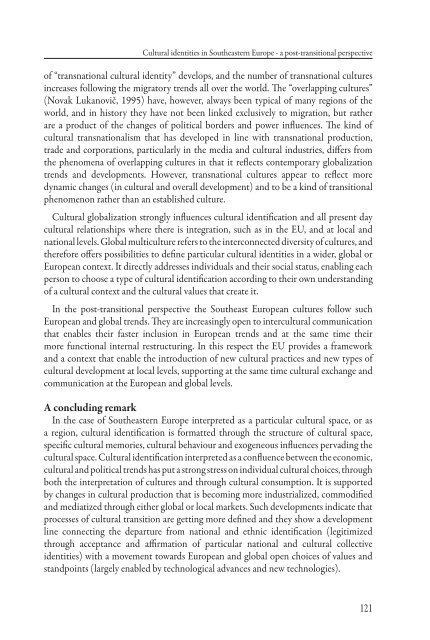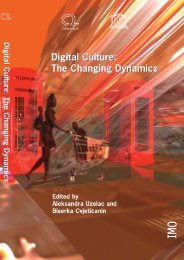free download in pdf format - Culturelink Network
free download in pdf format - Culturelink Network
free download in pdf format - Culturelink Network
Create successful ePaper yourself
Turn your PDF publications into a flip-book with our unique Google optimized e-Paper software.
Cultural identities <strong>in</strong> Southeastern Europe - a post-transitional perspective<br />
of “transnational cultural identity” develops, and the number of transnational cultures<br />
<strong>in</strong>creases follow<strong>in</strong>g the migratory trends all over the world. Th e “overlapp<strong>in</strong>g cultures”<br />
(Novak Lukanovič, 1995) have, however, always been typical of many regions of the<br />
world, and <strong>in</strong> history they have not been l<strong>in</strong>ked exclusively to migration, but rather<br />
are a product of the changes of political borders and power <strong>in</strong>fl uences. Th e k<strong>in</strong>d of<br />
cultural transnationalism that has developed <strong>in</strong> l<strong>in</strong>e with transnational production,<br />
trade and corporations, particularly <strong>in</strong> the media and cultural <strong>in</strong>dustries, diff ers from<br />
the phenomena of overlapp<strong>in</strong>g cultures <strong>in</strong> that it refl ects contemporary globalization<br />
trends and developments. However, transnational cultures appear to refl ect more<br />
dynamic changes (<strong>in</strong> cultural and overall development) and to be a k<strong>in</strong>d of transitional<br />
phenomenon rather than an established culture.<br />
Cultural globalization strongly <strong>in</strong>fl uences cultural identifi cation and all present day<br />
cultural relationships where there is <strong>in</strong>tegration, such as <strong>in</strong> the EU, and at local and<br />
national levels. Global multiculture refers to the <strong>in</strong>terconnected diversity of cultures, and<br />
therefore off ers possibilities to defi ne particular cultural identities <strong>in</strong> a wider, global or<br />
European context. It directly addresses <strong>in</strong>dividuals and their social status, enabl<strong>in</strong>g each<br />
person to choose a type of cultural identifi cation accord<strong>in</strong>g to their own understand<strong>in</strong>g<br />
of a cultural context and the cultural values that create it.<br />
In the post-transitional perspective the Southeast European cultures follow such<br />
European and global trends. Th ey are <strong>in</strong>creas<strong>in</strong>gly open to <strong>in</strong>tercultural communication<br />
that enables their faster <strong>in</strong>clusion <strong>in</strong> European trends and at the same time their<br />
more functional <strong>in</strong>ternal restructur<strong>in</strong>g. In this respect the EU provides a framework<br />
and a context that enable the <strong>in</strong>troduction of new cultural practices and new types of<br />
cultural development at local levels, support<strong>in</strong>g at the same time cultural exchange and<br />
communication at the European and global levels.<br />
A conclud<strong>in</strong>g remark<br />
In the case of Southeastern Europe <strong>in</strong>terpreted as a particular cultural space, or as<br />
a region, cultural identifi cation is <strong>format</strong>ted through the structure of cultural space,<br />
specifi c cultural memories, cultural behaviour and exogeneous <strong>in</strong>fl uences pervad<strong>in</strong>g the<br />
cultural space. Cultural identifi cation <strong>in</strong>terpreted as a confl uence between the economic,<br />
cultural and political trends has put a strong stress on <strong>in</strong>dividual cultural choices, through<br />
both the <strong>in</strong>terpretation of cultures and through cultural consumption. It is supported<br />
by changes <strong>in</strong> cultural production that is becom<strong>in</strong>g more <strong>in</strong>dustrialized, commodifi ed<br />
and mediatized through either global or local markets. Such developments <strong>in</strong>dicate that<br />
processes of cultural transition are gett<strong>in</strong>g more defi ned and they show a development<br />
l<strong>in</strong>e connect<strong>in</strong>g the departure from national and ethnic identifi cation (legitimized<br />
through acceptance and affi rmation of particular national and cultural collective<br />
identities) with a movement towards European and global open choices of values and<br />
standpo<strong>in</strong>ts (largely enabled by technological advances and new technologies).<br />
121



